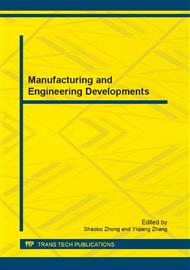[1]
Lisa. C. Ieonard and Vincent Toal, Roughness measurement of metallic surface based on the laser speckle contrast method, Optics and Laser Engineering, 2005, 30(5), pp.433-440.
DOI: 10.1016/s0143-8166(98)00036-0
Google Scholar
[2]
Peters. W. H and Ranson. W. F, Digital imaging techniques in experimental stress analysis, Opt. Eng. 1982, 21(5), pp.427-431.
Google Scholar
[3]
Saba Mirza, Rajesh Kumar, and Chandar Shakher, Study of various processing schemes and wavelet filters for speckle noise reduction in digital speckle pattern interferometric fringes, Optical Engineering, 2005, 44(4), pp.1-6.
DOI: 10.1117/1.1886749
Google Scholar
[4]
R. M. Haralick, C. N. Lee, and E. O. Karsten, Analysis and Solutions of the Three Point Perspective Pose Estimation Problem, Proc IEEE Conference on Computer Vision and Pattern Recognition, 1991, pp.592-598.
DOI: 10.1109/cvpr.1991.139759
Google Scholar
[5]
Diaz. F. V and Kaufmamm. G. H, Impact-induced transient deformation analysis by means of digital speckle interfermetry, Exp. Mech., 2005, 39(4), pp.311-316.
Google Scholar
[6]
Gulker. G and Hinsch. K, Electronic speckle pattern interferometry system for in site deformation monitoring on buildings, Opt. Eng., 2004, 29(7), pp.816-820.
DOI: 10.1117/12.55648
Google Scholar
[7]
Butters. J. N and Leendertz. J. A, Speckle pattern and Holographic Techniques in Engineering Metrology, Opt . Laser Tech., 1999, 32(1), pp.259-266.
Google Scholar
[8]
Stetson. K. A and Brohinsky. W. R, Electrooptic holography and its application to hologram interfermetry, Appl. Opt., 2006, 24(21), pp.361-367.
DOI: 10.1364/ao.24.003631
Google Scholar
[9]
Mohammad. S. Alam, Phase-encoded fring-adjusted joint transform correlation, Opt. Eng., 2002, 39(5), pp.1169-1176.
DOI: 10.1117/1.602482
Google Scholar
[10]
D. Lecomptea, A. Smitsb, and S. Bossuytb, Quality Assessment of Speckle Patterns for Digital Image Correlation, Optics and Lasers in Engineering, 2006, 44(5), pp.1132-1145.
DOI: 10.1016/j.optlaseng.2005.10.004
Google Scholar
[11]
Rafael. C. Gonzalez and Richard. E. Woods, Digital image processing second edition, Publishing House of Electronics indnstry, 2004, pp.420-450.
Google Scholar
[12]
Mahajan. A, Pilch. A, and Chu. T, Intelligent image correlation using genetic algorithms for measuring surface deformation in the autonomous inspection of structures, In Proceedings of the American Control Conference, Chicago, Illinois, 2000, pp.460-461.
DOI: 10.1109/acc.2000.878942
Google Scholar
[13]
Petra. A, Roland. H, and Karla. H, Optical full-field technique for measuring deflection and strain on micromechanical components, SPIE, 1999, 3875, pp.50-60.
Google Scholar
[14]
Nasser. A. Moustafa, Janos Kornis, and Zoltan Fuzessy, Comparative measurement by phase-shifting digital speckle interferometry using holographically generated reference wave, Opt. Eng., 1999, 38(7), pp.1241-1245.
DOI: 10.1117/1.602171
Google Scholar


